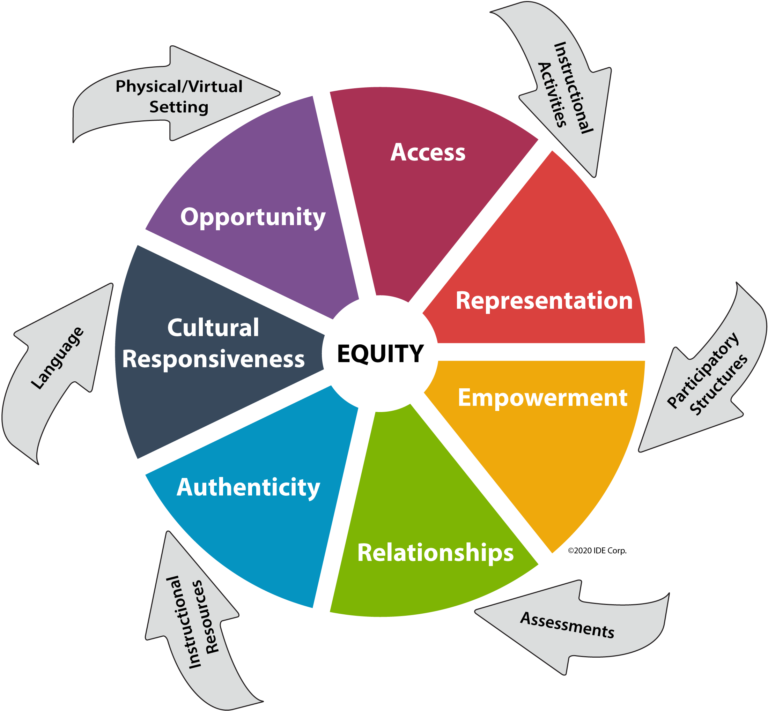Use the seven lenses of instructional equity to identify current issues within key areas of instruction and ways to address these issues.
Think back to the scenario you engaged in at the beginning of this module. Reflect on the thoughts and emotions you felt seeing the condition of your ladder and the challenging task ahead of you.
Just like your ladder, the issues surrounding the inequities in education must be addressed. How can you determine the strength and quality of your instructional equity implementation? As you continue to move forward in this course, consider the IDE Corp’s Seven Lenses of Instructional Equity.
Seven Lenses of Instructional Equity
 IDE Corp. views instructional equity through the following seven lenses:
IDE Corp. views instructional equity through the following seven lenses:
- Opportunity
- Access
- Empowerment
- Relationships
- Representation
- Authenticity
- Cultural Responsiveness
These seven lenses are reflected in the following six areas of instruction:
- Instructional activities
- Participatory structures
- Assessments
- Instructional resources
- Language
- Physical/virtual settings
More information about the Seven Lenses of Instructional Equity can be found on the IDE Corp. website.
Brainstorm and design
Read on to learn more about the lenses and consider how you can design a learning environment that supports Culturally Responsive-Sustaining Education.
For each of the seven lenses, consider:
- What equity issues emerge in the remote/ hybrid environment?
- How can you directly address these issues in your learning environment?
- What are the things outside of your immediate control that would address these issues on a larger scale?
Opportunity
Opportunity is a situation favorable for the attainment of a goal. We know that schools provide students with paths to college and career. The question is: “Does every student have the opportunity to receive a high-quality education, with a plethora of diverse resources available?”
Access
Access is often connected to opportunity because one must have the ability, permission, and tools to take advantage of an opportunity. What might hinder students from gaining access to high-quality education?
Empowerment
Dr. Nancy Sulla talks about the three Es: engagement, empowerment, and efficacy — in her book Building Executive Function: The Missing Link to Student Achievement. Equitable learning experiences promote students as independent learners and thinkers. Teachers empower students by resourcing them with the proper scaffolds they need to thrive in a learning environment.
Relationships
Building relationships to cultivate an environment of trust, safety, and respect must be a top priority. By doing so, teachers allow the space for students to engage in rigorous learning experiences. Get beyond the surface “knowing” of your students and find out who they are so that you can use their experiences to enrich the learning environment.
Representation
Representation truly matters! Every student should be able to see themselves represented in a positive way on the walls of your physical or virtual classroom, in the characters within the books they read, through a diversity of authors, and much more.
Authenticity
What issues or topics are of most interest to students? What are the needs of their communities? How might you anchor the learning to students’ lives and experiences? Authentic and relevant connections between the curriculum and student experience increase student engagement.
Cultural responsiveness
Cultural responsiveness is the utilization of cultures and backgrounds to inform our instructional practices. The key is to “focus on the roots of culture,” as noted by Zaretta Hammond in her book Culturally Responsive Teaching and the Brain. The first step is awareness, but from there, teachers must intentionally plan and design learning environments with culture in mind.
Stop and think
After you’ve reviewed the lenses and considered what equity issues emerge in your environment and how you can address them, stop and think:
- What is one of your biggest takeaways from this module?
- What next steps will you be taking?
